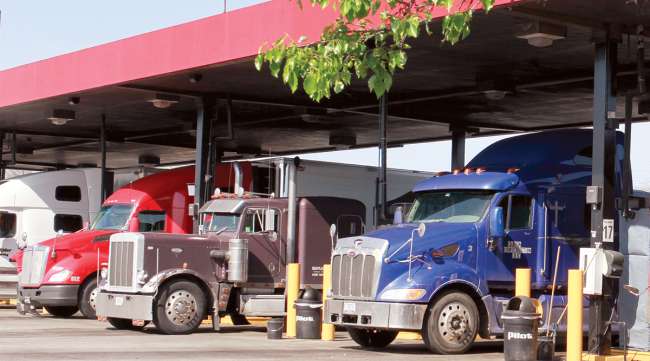Senior Reporter
Diesel Inches Up 0.4¢ to $3.07 Per Gallon

[Stay on top of transportation news: Get TTNews in your inbox.]
The U.S. average retail price of diesel rose 0.4 cent to $3.07 a gallon, the Department of Energy reported Dec. 2.
The price of a barrel of oil fell by $2 to just shy of $56 a barrel compared with a week earlier.
U.S. average #diesel fuel price on 12/02/2019 was $3.070/gal, UP 0.4¢/gallon from 11/25/19, DOWN 13.7¢/gallon from year ago https://t.co/L61ZntbpV7 #truckers #shippers #fuelprices pic.twitter.com/ecDA7GABJu
— EIA (@EIAgov) December 3, 2019
Trucking’s main fuel costs 13.7 cents less than it did a year ago, when it was $3.207 a gallon, according to DOE. Regional average diesel prices rose in five areas and fell in five others.
The U.S. average price of a gallon of gasoline fell 0.4 cent to $2.575 a gallon, according to DOE’s Energy Information Administration. The price is 1.24 cents higher than it was a year ago. Average gasoline prices rose in four regions and fell in five. Gasoline rose the most, 3.2 cents per gallon, in the Lower Atlantic region. It fell the most, 6.4 cents, on the West Coast.
U.S. average price for regular-grade #gasoline on 12/02/2019 was $2.575/gal, DOWN 0.4¢/gallon from 11/25/19, UP 12.4¢/gallon from year ago https://t.co/9QgCUfRYSt #gasprices pic.twitter.com/2yRSBImJlA — EIA (@EIAgov) December 3, 2019
Meanwhile, Autobon, a technology startup, is road-testing its autopilot aftermarket product that applies artificial intelligence programming and camera-based inputs to take limited control of the truck under certain conditions to improve fuel efficiency and safety as the drivers remain vigilant.
“We have one pilot project going on right now. We will have a second phase with more trucks later this year,” Autobon co-founder and CEO Krystian Gebis told Transport Topics. A large marketing effort is scheduled for January.
According to the Rolling Meadows, Ill.-based company, it has become ever more difficult for fleets to find and retain drivers who can efficiently and safely operate their vehicles. Therefore, fleets hire inexperienced drivers, those with five or fewer years of experience, who on average use 15% more fuel and are 41% more likely to cause accidents compared with experienced drivers.
“With autopilot controlling the throttle and braking much more efficiently based on machine learning, that’s a huge, huge efficiency and cost benefit to the fleet,” Gebis said. “The driver needs to be attentive always. This system is not replacing the driver, yet.”
The company’s plan is to install on customers’ trucks a replacement wind visor that houses what Gebis, who has a CDL and has made deliveries, described as a “low-cost sensor suite” consisting of seven multidirectional cameras, including ones with thermal vision, as well as radar and GPS accelerometers. Its visor is a universal enclosure that fits all truck models, he said, with “basically custom mounting brackets for each truck model. The visor itself takes about 15 minutes to install.”
While Autobon’s software does maintain an optimal speed, center the truck in the lane and perform braking as needed, it will not automatically change lanes.

Gebis
“That is a safety-critical component that we need much more data to validate against,” Gebis said.
Ultimately, over-the-air-updates to the software would enable that, he added. Two years ago, Gebis led a team of fellow student engineers from the University of Illinois-Chicago to a second-place finish in the 2017 NASA Robotic Mining Competition that drew more than 40 teams of undergraduate and graduate students from throughout the U.S.
Autobon is a unit of Autobon Holdings Inc.
West Texas Intermediate crude futures on the New York Mercantile Exchange closed at $55.96 Dec. 2 compared with $58.01 per barrel Nov. 25.
Oil surrendered some gains after disappointing economic data and a deterioration in U.S.-China trade relations undermined the outlook for global growth, according to Bloomberg News.
EIA reported U.S. commercial crude oil inventories, excluding those in the Strategic Petroleum Reserve, for the week ending Nov. 29 decreased by 4.9 million barrels compared with the week earlier. At 447.1 million barrels, inventories are about 3% above the five year average for this time of year.
At the same time, EIA data for September, the latest available period, showed monthly sales of No. 2 ultra-low sulfur diesel by refiners fell 6.3 million gallons per day, or 3.6%, to 170.1 million gallons per day. Retail sales declined 400,000 gallons per day, or 3.3%, while wholesales decreased 5.9 million gallons per day, or 3.6%.
Want more news? Listen to today's daily briefing:




